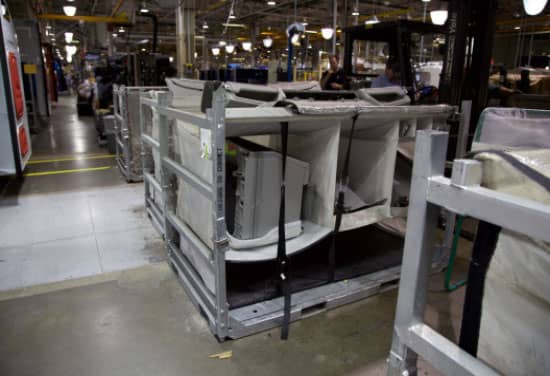
Plastic doors for fabric dunnage need to protect parts and withstand the environment. They also need to provide visibility so that workers can see what’s inside of rack bags without opening and closing the doors unnecessarily. Choosing the right door material is important, but packaging engineers should also consider how plastic doors attach to sewn fabric dunnage. Ultimately, doors that are easy-to-damage and hard-to-replace can mean taking rack bags out-of-service when you need them the most.
Dunnage Door Materials: PVC vs. PE
Plastic doors that are made of polyvinyl chloride (PVC) are used commonly with reusable packaging. PVC is strong and lightweight, but this thermoplastic won’t withstand prolonged exposure to sunlight and is prone to stress-cracking. That’s not just a problem if you need to store rack bags outdoors where the sun’s ultraviolet rays (UV) can yellow the plastic. UV-induced brittleness is also an issue since dunnage doors experience flexing whenever they’re opened and closed. Warehouses and assembly lines can also subject weakened plastics to puncturing and cracking from impacts.
Plastic doors that are made of polyethylene (PE) provide an attractive alternative to PVC. Different forms of PE are available, but this packaging material combines impact strength with rigidity. Importantly, PE plastic can also resist prolonged exposure to sunlight. When clear plastic doors begin to yellow, it’s difficult for workers to see through them. PE can maintain its optical clarity, a fact that workers like when they need to find parts quickly and don’t want to waste time opening and closing doors. PE plastic can also withstand frigid temperatures, something that companies in cold-weather climates appreciate.
Door Attachment Methods: Sewing vs. Velcro
Traditionally, suppliers of fabric dunnage have sewn plastic doors to rack bags. Sewn solutions are strong and reliable, but plastic doors that tear away from a rack bag need to be repaired. For example, if a forklift driver accidentally hits some returnable packaging that’s empty and left hanging, a plastic door may become detached and wind up on the floor. Even if the plastic door isn’t cracked, the rack bag must come out of service so that the door can be re-sewn to the rack bag.
Velcro provides an alternative method of attachment that eliminates the need for industrial sewing. When the ends are attached properly, Velcro won’t detach during normal operations such as the repeated opening and closing of doors. If a plastic door is detached accidentally, such as from the impact of a forklift, it’s easy to re-attach the door right on the shop floor. As long as the plastic isn’t damaged, workers can get the rack bag back in-service without ever removing the fabric dunnage from facility.
Ask Hold-True about Plastic Doors for Fabric Dunnage
Do you have questions about reusable packaging or fabric dunnage materials? Hold-True is a Made in the USA manufacturer of sewn fabric solutions that’s ready to help. Ask us about how we attach PE doors with Velcro for rack bags that provide a strong return on investment (ROI). To get started, contact us.

